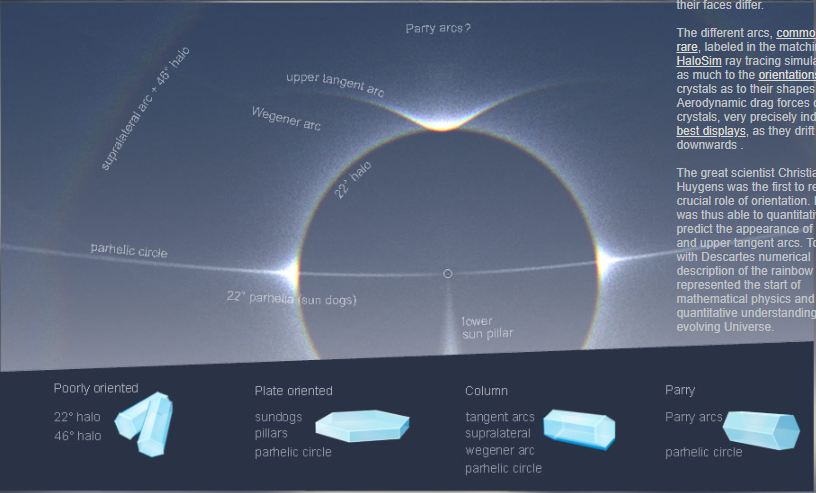Antarctic Halos
Antarctic Halos: A Spectacular Display of Atmospheric Optics
Antarctic Halos are a mesmerizing and captivating phenomenon that occur in the frigid landscapes of the southernmost continent. These stunning optical displays are created by the presence of plate-shaped and column-shaped ice crystals in the atmosphere. While both types of crystals possess identical interfacial angles, it is the relative sizes of their faces that differentiate them.
The intricate and diverse arcs that form during Antarctic Halos owe their existence not only to the shapes of the ice crystals but also to their orientations. As these crystals descend through the atmosphere, aerodynamic drag forces act upon them, aligning them with precision. This meticulous alignment contributes to the remarkable symmetry and clarity of the halos observed in the Antarctic skies.
It was the brilliant scientist Christiaan Huygens who first recognized the significance of crystal orientation in atmospheric optics. In 1662, Huygens made groundbreaking quantitative predictions about the appearance of sundogs and upper tangent arcs, based on his understanding of crystal alignment. This pivotal moment marked the beginning of mathematical physics and our evolving comprehension of the universe.
The Complexity of Antarctic Halos
Antarctic Halos encompass a range of arcs, both common and rare, which add to the complexity and beauty of these atmospheric phenomena. The precise angles and positions of these arcs are influenced by the orientation of the ice crystals, as well as their shapes. The interplay between crystal orientation, crystal shape, and atmospheric conditions results in an array of captivating optical effects.
Exploring the HaloSim Ray Tracing Simulation
To gain a deeper understanding of Antarctic Halos, scientists have utilized advanced tools such as HaloSim ray tracing simulations. These simulations enable researchers to model and predict the intricate patterns and formations observed in the Antarctic sky. By inputting data on crystal orientation, shape, and atmospheric conditions, scientists can recreate and analyze the mesmerizing displays of Antarctic Halos.
The Influence of Crystal Orientation
The aerodynamic forces acting on the ice crystals play a crucial role in determining their orientation. As the crystals descend through the atmosphere, they align themselves in a specific manner, dictated by the prevailing air currents. This alignment ensures that the crystals are positioned optimally to interact with sunlight and create the stunning halos visible to observers on the ground.
The Significance of Crystal Shape
While crystal orientation is a key factor in the formation of Antarctic Halos, crystal shape also contributes to the diversity and complexity of these atmospheric phenomena. The different shapes of the ice crystals, whether plate-shaped or column-shaped, result in variations in the size and arrangement of their faces. These variations further enhance the intricate patterns and arcs observed in Antarctic Halos.
Unveiling the Mysteries of Antarctic Halos
Studying Antarctic Halos provides scientists with valuable insights into the physics and optics of our atmosphere. By unraveling the complexities of crystal orientation and shape, researchers can deepen our understanding of light interaction with ice crystals and its impact on atmospheric phenomena. The data collected from observations and simulations of Antarctic Halos contribute to ongoing scientific advancements in the field of atmospheric optics.
Awe-Inspiring Displays in the Antarctic Skies
The ethereal beauty of Antarctic Halos serves as a reminder of the awe-inspiring wonders that nature has to offer. These captivating optical displays not only astound viewers but also provide a glimpse into the intricate workings of our atmosphere. As scientists continue to delve into the mysteries of Antarctic Halos, we gain a greater appreciation for the delicate interplay between light, ice crystals, and atmospheric conditions that give rise to these extraordinary phenomena.


Antarctic Halos at Casey Station 66°S on August 23, 2008 captured by Tom Delfatti. Image ©Tom Delfatti, shown with permission.
Plate shaped and column shaped ice crystals formed this display. Both types have identical interfacial angles, only the relative sizes of the their faces differ.
The different arcs, common and rare, labeled in the matching HaloSim ray tracing simulation owe as much to the orientations of the crystals as to their shapes. Aerodynamic drag forces orient the crystals, very precisely indeed in the best displays, as they drift downwards .
The great scientist Christiaan Huygens was the first to realize the crucial role of orientation. In 1662 he was thus able to quantitatively predict the appearance of sundogs and upper tangent arcs. Together with Descartes numerical description of the rainbow this represented the start of mathematical physics and our quantitative understanding of the evolving Universe.
Note: this article has been automatically converted from the old site and may not appear as intended. You can find the original article here.
Reference Atmospheric Optics
If you use any of the definitions, information, or data presented on Atmospheric Optics, please copy the link or reference below to properly credit us as the reference source. Thank you!
-
<a href="https://atoptics.co.uk/blog/antarctic-halos/">Antarctic Halos</a>
-
"Antarctic Halos". Atmospheric Optics. Accessed on November 24, 2024. https://atoptics.co.uk/blog/antarctic-halos/.
-
"Antarctic Halos". Atmospheric Optics, https://atoptics.co.uk/blog/antarctic-halos/. Accessed 24 November, 2024
-
Antarctic Halos. Atmospheric Optics. Retrieved from https://atoptics.co.uk/blog/antarctic-halos/.